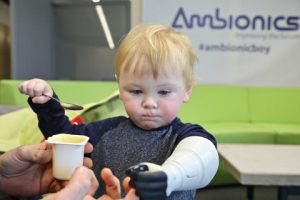Ambionics Develops Unique Child Prosthetic via Stratasys 3D Printing
March 2, 2017
Ben Ryan, founder of Ambionics, was able to create fully functioning 3D printed hydraulic prosthetic for his two year old son, Sol, using Stratasys Ltd.'s multi-material, multi-color PolyJet 3D printing technology.
 Two-year-old Sol with his fully-functioning Stratasys 3D printed hydraulic prosthetic arm, which enables him to move his thumb on his own. Photo courtesy of Business Wire.
Two-year-old Sol with his fully-functioning Stratasys 3D printed hydraulic prosthetic arm, which enables him to move his thumb on his own. Photo courtesy of Business Wire.Researching infant development with prosthetics, Ryan has developed a prosthetic for infants to wear. The customized design and production of the 3D printed hydraulic prosthetic has delivered cost savings of up to 76%, as well as time savings in design and production of 90%, compared with traditional methods of manufacture, according to Stratasys. This permits prosthetics to be used at an earlier developmental stage.
When Ryan’s son, Sol, was born in March 2015, complications resulted in the amputation of his lower left arm. Although able to keep approximately 1 in. of his lower arm, Sol would have to wait three years for a myoelectric prosthetic from the UK National Health Service, and one year before a cosmetic, non-functional prosthesis would be fitted. Instead of waiting, Ryan decided to act.
Having extensively researched infant development, Ryan used this knowledge to first design a foam arm for his son, and later a hydraulic prosthetic, enabling Sol to move his thumb on his own.
Ryan designed and created his 3D printed hydraulic prosthetic arm using the Stratasys Connex 3D Printer. First practicing with prototypes of his design, he 3D printed flexible actuators and a power-splitting unit (double acting helical bellow or DAHB) for the prosthetic. According to Ryan, the DAHB unit enables the wearer to open and close the thumb in manual mode or with assistive power (using compressed air or a hydraulic pump and reservoir), but the grip continues to operate manually in the event of power interruption.
“The success of my patented DAHB mechanism draws on the advanced capabilities of the Stratasys Connex Printer – the ability to combine rigid and soft materials in a single print was vital to the success of the design,” he says. “We were fortunate enough to have access to this technology, which enabled us to 3D print a prototype arm so quickly and cost-effectively. In founding Ambionics, it’s now my goal to ensure that other limb deficient children like my son are not faced with the current constraints and delays of traditional prosthetic manufacture.”
To develop the design for the prosthetic, Ryan relied on the use of Autodesk Fusion 360.
As well as its lightweight 3D printed design that weighs less than traditional myoelectric alternatives, the hydraulic prosthetic is body-powered and enables infants to grow accustomed to their “arm” earlier than traditional fittings. The ability to operate without the need for any electronic devices or batteries is unique to the Ambionics design and mitigates the risk of injury.
Arm Scan to Wearable Prosthetic in Five Days
Ryan was able to produce the prosthetic in only five days. With the flexibility to keep the scan on file, the digital copy allows replacement prosthetics to be easily produced through 3D printing.
“Essentially the entire prosthetic is 3D printed,” Ryan says. “Only Stratasys’ strong rubber-like and dissolvable support 3D printing materials make production and use of the DAHB units possible. The internal cavities are complex and it would be impossible to remove the support material using mechanical means. The materials must also be strong yet flexible as they are used to transmit fluid pressure to operate the grip.”
Having patented its DAHB technology inside the prosthetic, Ambionics is aiming to offer the service to healthcare providers worldwide. Continuing its research and testing into infant development with prosthetics, the company started a Crowdfunding campaign on March 1 to enable medical device usability trials, which are required before seeking authorization to launch the product into the market.
For more information, visit Stratasys.
Sources: Press materials received from the company.
Subscribe to our FREE magazine, FREE email newsletters or both!






